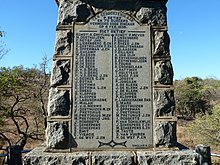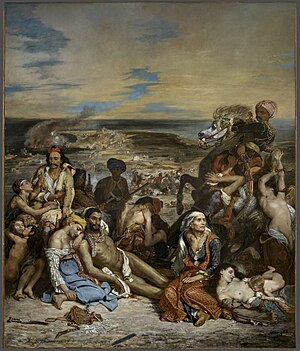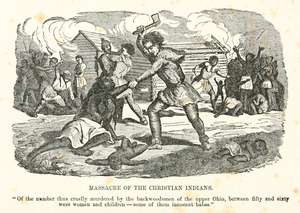Result
Lamey Island Massacre

Lamey Island Massacre
20/02/2022 14:39:52The Lamey or Liuqiu Island Massacre was the slaughter of aboriginal inhabitants of Liuqiu Island (then known as "Lamey" or "Golden Lion Island") off the coast of Taiwan by Dutch soldiers in 1636. The killings were part of a punitive campaign in retaliation for the massacre of shipwrecked Dutch sailors in two separate incidents in 1622 and 1631 by natives of the island.
Myall Creek massacre

Myall Creek massacre
20/02/2022 14:39:51The Myall Creek massacre was the killing of at least twenty-eight unarmed Indigenous Australians by twelve colonists on 10 June 1838 at the Myall Creek near the Gwydir River, in northern New South Wales. After two trials, seven of the twelve colonists were found guilty of murder and hanged, a verdict which sparked extreme controversy within New South Welsh settler society. One—the leader and free settler John Fleming—evaded arrest and was never tried. Four were never retried following the not guilty verdict of the first trial.
Weenen massacre

Weenen massacre
20/02/2022 14:39:50Battles
Piet Retief Delegation massacre

Piet Retief Delegation massacre
20/02/2022 14:39:49Battles
Dade battle

Dade battle
20/02/2022 14:39:46Cutthroat Gap massacre

Cutthroat Gap massacre
20/02/2022 14:39:45The Cutthroat Gap massacre occurred in 1833, "The Year the Stars Fell" in Oklahoma. A group of Osage warriors charged into a Kiowa camp and brutally slaughtered the women, children and elderly there. Most of the warriors of this group of Kiowas, headed by Chief A'date (IPA: [ɔ́ːtɔ́ːtè]) or "Islandman" had left to raid a band of Utes or had gone bison hunting. The camp was left mainly unguarded and when the Osage came, the Kiowas had no choice but to flee. The Osage killed approximately 150 Kiowa people and took their sacred Tai-me (IPA: [thã́jmẽ́]) medicine bundle and two children captive.
Kasos Massacre

Kasos Massacre
20/02/2022 14:39:431822–1824
...Naousa massacre

Naousa massacre
20/02/2022 14:39:421822–1824
...Chios massacre

Chios massacre
20/02/2022 14:39:411822–1824
...Navarino massacre

Navarino massacre
20/02/2022 14:39:401822–1824
...Madulla

Madulla
20/02/2022 14:39:37Madulla is a village located in the Moneragala District of Uva Province, Sri Lanka.
The village is situated on the Inginiyagala Road (B527), adjacent to the Gal Oya National Park.
Fort Mims massacre

Fort Mims massacre
20/02/2022 14:39:36Decisive Red Stick victory
Red Sticks take Fort Mims and kill inhabitants
| Date | August 30, 1813 |
|---|---|
| Location | 35 to 40 miles north of Mobile, Alabama near Bay Minette, Alabama |
| Result |
Decisive Red Stick victory Red Sticks take Fort Mims and kill inhabitants |
Head warriors (Tastanagi):
William Weatherford
Peter McQueen
Dixon Bailey
265 militia, including:
- 70 Tensaw home militia
- 175 Mississippi volunteers
- 16 from Fort Stoddard
unknown wounded
252 civilians killed or captured
unknown wounded
Fort Mims severely damaged
Introduction
1804 Haiti massacre

1804 Haiti massacre
20/02/2022 14:39:34The 1804 Haiti massacre was carried out against the French population and French Creoles (or Franco-Haitians) remaining in Haiti following the Haitian Revolution, by soldiers, mostly former slaves, under orders from Jean-Jacques Dessalines. He had decreed that all suspected of conspiring in the acts of the expelled army should be put to death. From early January 1804 until 22 April 1804, squads of soldiers moved from house to house throughout Haiti, torturing and killing entire families. Eyewitness accounts of the massacre describe imprisonment and killings even of whites who had been friendly and sympathetic to the black population. Between 3,000 and 5,000 people were killed.
Nicholas A. Robins and Adam Jones describe the massacre as a "genocide of the subaltern", in which an oppressed group uses genocidal means to destroy their oppressors. Throughout the early-to-mid nineteenth century, the events of the massacre were well known in the United States. In addition, many refugees had come to the U.S. from Saint-Domingue, settling in New Orleans, Charleston, New York, Baltimore and other coastal cities. These events polarized Southern U.S. public opinion on the question of the abolition of slavery.
...Erfurt massacre (1349)

Erfurt massacre (1349)
20/02/2022 14:39:34The Erfurt massacre was a massacre of the Jewish community in Erfurt, Germany, on 21 March 1349. Accounts of the number of Jews killed in the massacre vary widely from between 100 and up to 3000. Any Jewish survivors were expelled from the city. Some Jews set fire to their homes and possessions and perished in the flames before they could be lynched.
The many Black Death persecutions and massacres that occurred in France and Germany at that time were sometimes in response to accusations that the Jews were responsible for outbreaks of the Black Death, and other times justified with the belief that killing the local Jews would prevent the spread of the Black Death to that locale. Although these beliefs, and the accompanying massacres, were frequently encouraged by local bishops or itinerant Flagellants, the Catholic Church, including Pope Clement VI under whom the Flagellants and the Black Death began, and his successor, Innocent VI, were firmly against it. In a papal bull condemning the Flagellant movement in late 1349, Pope Clement VI criticized their "shedding the blood of Jews". Erfurt later suffered the ravages of the Black Plague, where over 16,000 residents died during a ten-week period in 1350.
...Battle of Praga

Battle of Praga
20/02/2022 14:39:33
Obrona Pragi, Aleksander Orłowski
| Date | 4 November 1794 |
|---|---|
| Location | |
| Result | Russian victory |
14,680 captured
Introduction
First Massacre of Machecoul

First Massacre of Machecoul
20/02/2022 14:39:31The Machecoul massacre is one of the first events of the War in the Vendée, a revolt against mass conscription and the civil constitution of the clergy. The first massacre took place on 11 March 1793, in the provincial city of Machecoul, in the district of the lower Loire. The city was a thriving center of grain trade; most of the victims were administrators, merchants and citizens of the city.
Although the Machecoul massacre, and others that followed it, are often viewed (variously) as a royalist revolt, or a counter-revolution, twenty-first century historians generally agree that Vendee revolt was a complicated popular event brought on by anti-clericalism of the Revolution, mass conscription, and Jacobin anti-federalism. In the geographic area south of the Loire, resistance to recruitment was particularly intense, and much of this area also resented intrusion by partisans of the republic, called "blue coats", who brought with them new ideas about district and judicial organization, and who required reorganization of parishes with the so-called juring priests (those who had taken the civil oath). Consequently, the insurgency became a combination of many impulses, at which conscription and the organization of parishes led the list. The response to it was incredibly violent on both sides.
...September Massacres

September Massacres
20/02/2022 14:39:30
The September Massacres were a series of killings of prisoners in Paris that occurred in 1792, from Sunday Sept 2 until Thursday Sept 6, during the French Revolution. Half the prison population of Paris,[page needed] between 1,176 and 1,614 people, were killed by fédérés, guardsmen, and sansculottes, with the support of gendarmes responsible for guarding the tribunals and prisons, the Cordeliers, the insurrectional commune, and the revolutionary sections of Paris.
With widespread fear that foreign and royalist armies would attack Paris, and that the imprisoned Swiss mercenaries would be freed to join them, on 1 September the Legislative Assembly called for volunteers to gather the next day on the Champs de Mars. On 2 September, around 1:00 pm, Georges Danton, delivered a speech in the assembly, stating: "We ask that anyone refusing to give personal service or to furnish arms shall be punished with death. The bell we are about to ring... sounds the charge on the enemies of our country." The massacres began around 2:30 pm in the middle of Saint-Germain-des-Prés, and within the first 20 hours more than 1,000 prisoners lost their lives.
...Olowalu Massacre

Olowalu Massacre
20/02/2022 14:39:28Olowalu Massacre was a massacre that took place in Maui in 1790. In 1789, American Captain Simon Metcalfe set out on a maritime fur trading mission with two ships: the large Eleanora, and the tender Fair American, a schooner under command of his son Thomas Humphrey Metcalfe. The Fair American was captured by the Spanish during the Nootka Crisis and taken to Mexico, but quickly released. The Metcalfes had earlier agreed to rendezvous in the Hawaiian Islands at Kealakekua Bay.
The Eleanora had arrived by January 1790, and met chief Kameʻeiamoku who boarded the ship to welcome them. An unknown action by the chief offended Simon Metcalfe, who had him flogged, which would have severe consequences later. The Eleanora then sailed north to the island of Maui to trade and resupply. One night a small boat was stolen and the night watchman was killed. Captain Metcalfe fired his cannons into the village, and captured a few Hawaiians who told him the boat was taken by people from the village of Olowalu.
...Gnadenhutten massacre

Gnadenhutten massacre
20/02/2022 14:39:27
An 1852 woodcut depicting the Gnadenhutten Massacre
| Date | March 8, 1782 |
|---|---|
| Location | |
| Result | 96 unarmed civilians killed |
Introduction
Pyle's Massacre

Sugarloaf massacre

Sugarloaf massacre
20/02/2022 14:39:24The Sugarloaf massacre was a skirmish that occurred on September 11, 1780, in the U.S. state of Pennsylvania when a number of Natives and a handful of loyalists attacked a small detachment of militia from Northampton County. According to pension files and witness depositions, the militia detachment was led by Lieutenants John Moyer and John Fish of Captain Johannes Van Etten's company of volunteers.
Battle of Waxhaws

Cherry Valley massacre

Cherry Valley massacre
20/02/2022 14:39:22
Cherry Valley massacre, the fate of Jane Wells, one of thirty non-combatants killed during the massacre.
| Date | November 11, 1778 |
|---|---|
| Location | |
| Result | British victory |
William Stacy (POW)
- 7th Massachusetts Regiment
- 250 settlers and militia
- 321 Iroquois
- 150 Butler's Rangers
- 50 8th Regiment of Foot
- 14 soldiers killed
- 11 soldiers captured
- 30 inhabitants killed
- 30 inhabitants taken into captivity
Introduction
Cao Cao's invasion of Xu Province

Cao Cao's invasion of Xu Province
20/02/2022 14:39:22Cao Cao's invasion of Xu Province was a punitive invasion launched by the warlord Cao Cao against Tao Qian, the Governor of Xu Province, in the late Eastern Han dynasty. The casus belli for the invasion was the murder of Cao Cao's father, Cao Song, in Xu Province. Although Tao Qian's culpability was questionable, Cao Cao nonetheless held him responsible. The invasion took place in two separate waves in 193 and 194, during each of which Cao Cao captured a number of towns and engaged in collective punishment of the civilian populace.
Affair at Little Egg Harbor

Affair at Little Egg Harbor
20/02/2022 14:39:21| Date | October 15, 1778 |
|---|---|
| Location | near Little Egg Harbor, present-day Tuckerton, New Jersey |
| Result | British victory |
5 captured
3 wounded
Introduction
Boston Massacre

Boston Massacre
20/02/2022 14:39:18The Boston Massacre was a confrontation in Boston on March 5, 1770, in which a group of nine British soldiers killed three people of a crowd of three or four hundred who were abusing them verbally and throwing various missiles. The event was heavily publicized as "a massacre" by leading Patriots such as Paul Revere and Samuel Adams. British troops had been stationed in the Province of Massachusetts Bay since 1768 in order to support crown-appointed officials and to enforce unpopular Parliamentary legislation.
Amid tense relations between the civilians and the soldiers, a mob formed around a British sentry and verbally abused him. He was eventually supported by seven additional soldiers, led by Captain Thomas Preston, who were hit by clubs, stones, and snowballs. Eventually, one soldier fired, prompting the others to fire without an order by Preston. The gunfire instantly killed three people and wounded eight others, two of whom later died of their wounds.
The crowd eventually dispersed after Acting Governor Thomas Hutchinson promised an inquiry, but they re-formed the next day, prompting the withdrawal of the troops to Castle Island. Eight soldiers, one officer, and four civilians were arrested and charged with murder, and they were defended by future U.S. President John Adams. Six of the soldiers were acquitted; the other two were convicted of manslaughter and given reduced sentences. The two found guilty of manslaughter were sentenced to branding on their hand.
...Massacre of St George's Fields

Massacre of St George's Fields
20/02/2022 14:39:17The Massacre of St George's Fields occurred on 10 May 1768 when government soldiers opened fire on demonstrators that had gathered at St George's Fields, Southwark, in south London. The protest was against the imprisonment of the radical Member of Parliament John Wilkes for writing an article that severely criticised King George III. After the reading of the Riot Act telling the crowds to disperse within the hour, six or seven people were killed when fired on by troops. The incident in Britain entrenched the enduring idiom of "reading the Riot Act to someone", meaning "to reprimand severely", with the added sense of a stern warning. The phrase remains in common use in the English language.
Penn's Creek massacre

Penn's Creek massacre
20/02/2022 14:39:15The Penn's Creek massacre was an October 16, 1755 raid by Lenape (Delaware) Native Americans on a settlement along Penn's Creek, a tributary of the Susquehanna River in central Pennsylvania. It was the first of a series of deadly raids on Pennsylvania settlements by Native Americans allied with the French in the French and Indian War.
Of the 26 settlers they found living on Penn's Creek, the Lenape killed 14 and took 11 captive (one man was wounded but managed to escape). Three of the preteen girls who were taken captive regained their freedom after years of slavery, and their stories have been popularized in several young adult novels and a film.
The Lenape had been angered by years of European settlers encroaching on their land. They had lost their traditional lands in the Lehigh Valley to the provincial government of Pennsylvania in a fraudulent deal known as the Walking Purchase, and many of them had subsequently moved into the Susquehanna Valley by permission of the Iroquois. One year before the Penn's Creek massacre, the Iroquois had sold much of the Susquehanna Valley to the governments of Pennsylvania and Connecticut without consulting the Lenape, who once again found themselves being displaced by arriving settlers.
...1740 Batavia massacre

1740 Batavia massacre
20/02/2022 14:39:14The 1740 Batavia massacre (Dutch: Chinezenmoord, lit. 'Murder of the Chinese'; French: Meurtre des Chinois, lit. 'Murder of the Chinese'; Indonesian: Geger Pacinan, lit. 'Chinatown Tumult') was a massacre in which Javanese people and soldiers of the VOC killed ethnic Chinese residents of the port city of Batavia (present-day Jakarta) in the Dutch East Indies. The violence in the city lasted from 9 October 1740 until 22 October, with minor skirmishes outside the walls continuing late into November that year. Historians have estimated that at least 10,000 ethnic Chinese were massacred; just 600 to 3,000 are believed to have survived.
...Massacre of Glencoe

Massacre of Glencoe
20/02/2022 14:39:12The Massacre of Glencoe (Scottish Gaelic: Murt Ghlinne Comhann) took place in Glen Coe in the Highlands of Scotland on 13 February 1692. An estimated 30 members and associates of Clan MacDonald of Glencoe were killed by Scottish government forces, allegedly for failing to pledge allegiance to the new monarchs, William III and Mary II.
Although the Jacobite rising of 1689 was no longer a serious threat by May 1690, unrest continued in the remote Highlands which consumed resources needed for the Nine Years' War in Flanders. In late 1690, the Scottish government agreed to pay the Jacobite clans a total of £12,000 for swearing loyalty. However, arguments between the chiefs over how to divide the money meant by December 1691 they still had not done so.
Under pressure from William, Secretary of State Lord Stair decided to make an example as a warning of the consequences for further delay. The Glencoe MacDonalds were not the only ones who failed to meet the deadline, as the Keppoch MacDonalds did not swear until early February. The reason for their selection is still debated, but appears to have been a combination of internal clan politics, and a reputation for lawlessness that made them an easy target.
...